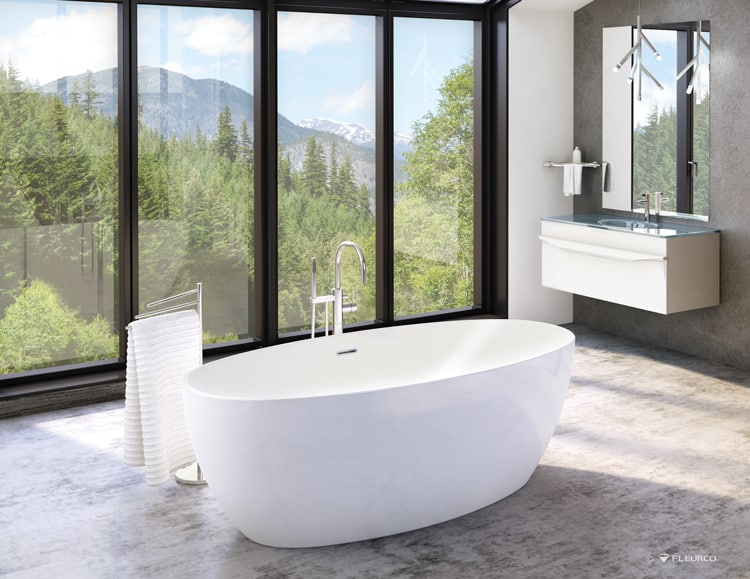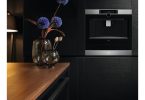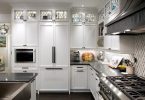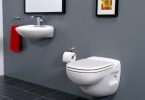
Photo Source: Fleurco
The latest wave of freestanding tubs is making a splash in the world of bathroom design. They are attention-commanding statement pieces, beloved both for their aesthetics and for the deep soak they can provide.
Whether intended for a bathroom makeover or new build, a freestanding tub can instantly provide the luxurious spa feeling that many homeowners covet. Available in an extensive variety of styles and materials, they work beautifully with most design styles, from farmhouse to contemporary and beyond.
When shopping around for the ideal tub to be featured in your new bathroom, there are several factors that you should consider. Since freestanding tubs play much more of a starring role than the integrated variety, you will find that the emphasis on looks will be a much bigger part of your overall consideration.
Tub Size
Freestanding bathtubs are available in a variety of different lengths and widths. Most suppliers offer tubs starting at 45 inches long, all the way up to 75 inches and beyond. Typical tub widths start at 25 inches and extend to 45 inches wide and sometimes even wider.
Another factor to keep in mind when searching for your new freestanding tub is who will be using it. If you happen to be a petite person, and only plan to use the tub solo, then you can safely get away with something more compact. However, a tall person, or a family with more than one kid at a time enjoying the tub, will want to shop for something roomier.
Freestanding tubs look best when surrounded by a generous amount of negative space. This means that you may want to consider a model that doesn’t completely dominate the allotted space.
Tub Features
While the primary feature of any bathtub is that it allows you to enjoy a good soak, there are several more options to consider. The technology available in freestanding tubs has advanced greatly. This makes is possible for you to enjoy the beauty and style of a freestanding tub, along with additional features that are more often found in an integrated tub.
Available features may include things like air bath technology, whirlpool jets, and a heated surface.
Tub Design
Freestanding tubs are available in several different designs and styles. Whether your bathroom is rustic or high-end, you can find a tub that complements your décor. Here are some of the styles you can find on the market:
Clawfoot – The classic, freestanding-style tub. As the name suggests, clawfoot tubs are lifted off of the ground by four typically ornately, designed feet.
Pedestal –This style of tub is elevated by a pedestal base.
Slipper Tubs – Slipper tubs are higher on one end than on the other. This shape makes it more comfortable for leisurely soaking.
Double Slipper Tubs – These tubs are high on both ends, allowing for a comfortable couple’s soak.
Ofuro Tubs – These are deep, Japanese soaking tubs that allow users to soak up to the neck in steaming water.
Material
Tub construction is another area that you’ll need to consider when shopping for a new, freestanding tub. The factors that go into making this choice are cost, durability and looks. For the most part, any style of tub can be found in most of the following materials. However, as in the case of Ofuro tubs, options may be limited.
Enameled Tubs – Enameled tubs are constructed of steel with a porcelain overlay. Pros of this option are that they are easy to clean, durable, and offer a vintage look. On the Cons side, they tend to be very heavy and can chip under impact.
Acrylic –This option wraps formed sheets of acrylic around air or fiberglass, to create a tub that is lightweight and low-maintenance. This versatile material and construction allows tubs to be crafted in a number of different colours and shapes.
Wood –Most bathtubs found in North America are not made of wood. However, Japanese soaking tubs are often constructed from Hinoki wood or Port Orford Cedar. These woods are used for their antiseptic properties.
Cast Iron –If you’re looking for a tub that will last for generations, cast iron is the choice for you. These tubs are made from molten iron that has been coated with enamel. It’s chip-resistant, scratch-resistant, dent-resistant, and extremely heavy. In fact, installing a cast iron tub often requires extra floor reinforcement. Not surprisingly, it’s among the most expensive tub materials on the market.
Stone –Marble, travertine, and granite tubs are a luxurious splurge. This style of tub definitely commands attention … and demands a healthy budget.
Solid Surface –This option provides the look of stone, but at a lower cost and at a lighter weight.
With such a wide variety of tub styles, materials and sizes, it’s easy to see that there are options available to suit almost any budget and style. The perfect freestanding tub is out there and waiting to play a starring role in your bathroom renovation.
—Visit eieihome.com for more home improvement articles, to read contractor reviews and connect with home improvement professionals.
Republished with permission from eieihome.com | About the Author: Darla Grant-Braid is the principal home improvement writer and editor for eieihome.com.
Follow eieihome.com: Facebook | Twitter | Instagram | Pinterest
Latest posts by Canadian Home Trends (see all)
- Layer Up – Wrap Your Bathroom In Light - January 1, 2026
- The Power of Rest: Elevate Your Wellness with Better Sleep - January 1, 2026
- VERSATILE KITCHEN DESIGN - January 1, 2026






